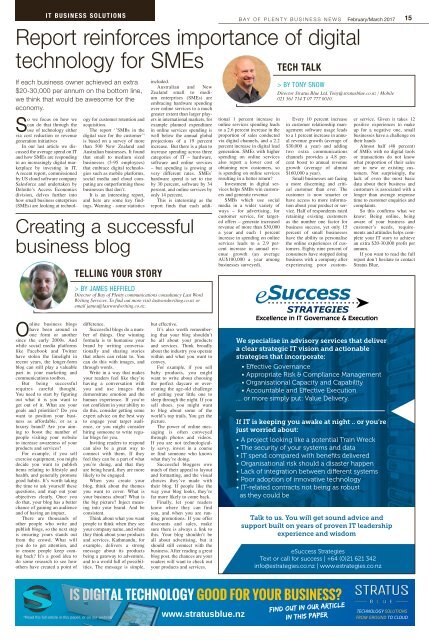Bay of Plenty Business News February/March 2017
From mid-2016 Bay of Plenty businesses have a new voice, Bay of Plenty Business News. This new publication reflects the region’s growth and importance as part of the wider central North Island economy.
From mid-2016 Bay of Plenty businesses have a new voice, Bay of Plenty Business News. This new publication reflects the region’s growth and importance as part of the wider central North Island economy.
Create successful ePaper yourself
Turn your PDF publications into a flip-book with our unique Google optimized e-Paper software.
IT BUSINESS SOLUTIONS<br />
BAY OF PLENTY BUSINESS NEWS <strong>February</strong>/<strong>March</strong> <strong>2017</strong> 15<br />
Report reinforces importance <strong>of</strong> digital<br />
technology for SMEs<br />
If each business owner achieved an extra<br />
$20-30,000 per annum on the bottom line,<br />
we think that would be awesome for the<br />
economy.<br />
So we focus on how we<br />
can do that through the<br />
use <strong>of</strong> technology either<br />
via cost reduction or revenue<br />
generation initiatives<br />
In our last article we discussed<br />
the average spend on IT<br />
and how SMEs are responding<br />
to an increasingly digital marketplace<br />
by investing in IT.<br />
A recent report, commissioned<br />
by US cloud s<strong>of</strong>tware company<br />
Salesforce and undertaken by<br />
Deloitte’s Access Economics<br />
division, delves further into<br />
how small business enterprises<br />
(SMEs) are looking at technol-<br />
ogy for customer retention and<br />
acquisition.<br />
The report ‘’SMBs in the<br />
digital race for the customer’’<br />
is based on a survey <strong>of</strong> more<br />
than 500 New Zealand and<br />
Australian businesses. It found<br />
that small to medium sized<br />
businesses (5-95 employees)<br />
that embrace digital technologies<br />
such as mobile platforms,<br />
social media and cloud computing<br />
are outperforming those<br />
businesses that don’t.<br />
It is an interesting report,<br />
and here are some key findings.<br />
Warning - some statistics<br />
Creating a successful<br />
business blog<br />
TELLING YOUR STORY<br />
> BY JAMES HEFFIELD<br />
Director <strong>of</strong> <strong>Bay</strong> <strong>of</strong> <strong>Plenty</strong> communications consultancy Last Word<br />
Writing Services. To find out more visit lastwordwriting.co.nz or<br />
email james@lastwordwriting.co.nz.<br />
included.<br />
Australian and New<br />
Zealand small to medium<br />
enterprises (SMEs) are<br />
embracing hardware spending<br />
over online services to a much<br />
greater extent than larger players<br />
in international markets, for<br />
example planned expenditure<br />
in online services spending is<br />
well below the annual global<br />
projections <strong>of</strong> a 19 percent<br />
increase. But there is a plan to<br />
increase spending across three<br />
categories <strong>of</strong> IT – hardware,<br />
s<strong>of</strong>tware and online services<br />
– but spending is growing at<br />
very different rates. SMEs’<br />
hardware spend is set to rise<br />
by 30 percent, s<strong>of</strong>tware by 34<br />
percent, and online services by<br />
only 14 percent.<br />
This is interesting as the<br />
report finds that each additional<br />
1 percent increase in<br />
online services spending leads<br />
to a 2.6 percent increase in the<br />
proportion <strong>of</strong> sales conducted<br />
via digital channels, and a 2.2<br />
percent increase in digital lead<br />
generation. SMEs with higher<br />
spending on online services<br />
also report a lower cost <strong>of</strong><br />
obtaining new customers, so<br />
is spending on online services<br />
resulting in a better return?<br />
Investment in digital services<br />
helps SMBs win customers<br />
and generate revenue<br />
SMBs which use social<br />
media in a wider variety <strong>of</strong><br />
ways – for advertising, for<br />
customer service, for targeted<br />
<strong>of</strong>fers – generate increased<br />
revenue <strong>of</strong> more than $30,000<br />
a year and each 1 percent<br />
increase in spending on online<br />
services leads to a 2.9 percent<br />
increase in annual revenue<br />
growth (an average<br />
AU$100,000 a year among<br />
businesses surveyed).<br />
TECH TALK<br />
> BY TONY SNOW<br />
Director Stratus Blue Ltd. Tony@stratusblue.co.nz | Mobile<br />
021 361 714 T 07 777 0010.<br />
Every 10 percent increase<br />
in customer relationship management<br />
s<strong>of</strong>tware usage leads<br />
to a 1 percent increase in annual<br />
revenue growth (average <strong>of</strong><br />
$30,000 a year) and adding<br />
two extra communications<br />
channels provides a 4.8 percent<br />
boost to annual revenue<br />
growth (average <strong>of</strong> almost<br />
$160,000 a year).<br />
Small businesses are facing<br />
a more discerning and critical<br />
customer than ever. The<br />
customer is now smarter or<br />
have access to more information<br />
about your product or service.<br />
Half <strong>of</strong> respondents rated<br />
retaining existing customers<br />
as the number one factor for<br />
business success, yet only 15<br />
percent <strong>of</strong> small businesses<br />
have the ability to personalise<br />
the online experiences <strong>of</strong> customers.<br />
Eighty nine percent <strong>of</strong><br />
consumers have stopped doing<br />
business with a company after<br />
experiencing poor customer<br />
service. Given it takes 12<br />
positive experiences to make<br />
up for a negative one, small<br />
businesses have a challenge on<br />
their hands<br />
Almost half (48 percent)<br />
<strong>of</strong> SMEs with no digital tools<br />
or transactions do not know<br />
what proportion <strong>of</strong> their sales<br />
are to new or existing customers.<br />
Not surprisingly, the<br />
lack <strong>of</strong> even the most basic<br />
data about their business and<br />
customers is associated with a<br />
longer than average response<br />
time to customer enquiries and<br />
complaints.<br />
So this confirms what we<br />
know: Being online, being<br />
aware <strong>of</strong> your business and<br />
customer’s needs, requirements<br />
and attitudes helps complete<br />
your IT story to achieve<br />
an extra $20-30,000 pr<strong>of</strong>it per<br />
annum.<br />
If you want to read the full<br />
report don’t hesitate to contact<br />
Stratus Blue.<br />
Online business blogs<br />
have been around in<br />
one form or another<br />
since the early 2000s. And<br />
while social media platforms<br />
like Facebook and Twitter<br />
have stolen the limelight in<br />
recent years, the longer-form<br />
blog can still play a valuable<br />
part in your marketing and<br />
communications toolbox.<br />
But being successful<br />
requires careful thought.<br />
You need to start by figuring<br />
out what it is you want to<br />
get out <strong>of</strong> it. What are your<br />
goals and priorities? Do you<br />
want to position your business<br />
as affordable, or as a<br />
luxury brand? Are you aiming<br />
to boost the number <strong>of</strong><br />
people visiting your website<br />
to increase awareness <strong>of</strong> your<br />
products and services?<br />
For example, if you sell<br />
exercise equipment, you might<br />
decide you want to publish<br />
items relating to lifestyle and<br />
health, and generally promote<br />
good habits. It’s worth taking<br />
the time to ask yourself these<br />
questions, and map out your<br />
objectives clearly. Once you<br />
do that, your blog has a better<br />
chance <strong>of</strong> gaining an audience<br />
and <strong>of</strong> having an impact.<br />
There are thousands <strong>of</strong><br />
other people who write and<br />
publish blogs, so the next step<br />
is ensuring yours stands out<br />
from the crowd. What will<br />
you do to get attention, and<br />
to ensure people keep coming<br />
back? It’s a good idea to<br />
do some research to see how<br />
others have created a point <strong>of</strong><br />
difference.<br />
Successful blogs do a number<br />
<strong>of</strong> things. One winning<br />
formula is to humanise your<br />
brand by writing conversationally<br />
and sharing stories<br />
that others can relate to. You<br />
can do this with images, and<br />
through words.<br />
Write in a way that makes<br />
your readers feel like they’re<br />
having a conversation with<br />
you and use images that<br />
demonstrate emotion and the<br />
human experience. If you’re<br />
not confident in your ability to<br />
do this, consider getting some<br />
expert advice on the best way<br />
to engage your target audience,<br />
or you might consider<br />
hiring someone to write regular<br />
blogs for you.<br />
Inviting readers to respond<br />
can also be a great way to<br />
connect with them. If they<br />
feel they can be a part <strong>of</strong> what<br />
you’re doing, and that they<br />
are being heard, they are more<br />
likely to be engaged.<br />
When you create your<br />
blog, think about the themes<br />
you want to cover. What is<br />
your business about? What is<br />
the big picture? Inject meaning<br />
into your brand. And be<br />
consistent.<br />
Think about what you want<br />
people to think when they see<br />
your company name, and when<br />
they think about your products<br />
and services. Kathmandu, for<br />
example, delivers a strong<br />
message about its products<br />
being a gateway to adventure,<br />
and to a world full <strong>of</strong> possibilities.<br />
The message is simple,<br />
but effective.<br />
It’s also worth remembering<br />
that your blog shouldn’t<br />
be all about your products<br />
and services. Think broadly<br />
about the industry you operate<br />
within and what you want to<br />
convey.<br />
For example, if you sell<br />
baby products, you might<br />
want to write about choosing<br />
the perfect daycare or overcoming<br />
the age-old challenge<br />
<strong>of</strong> getting your little one to<br />
sleep through the night. If you<br />
sell shoes, you might want<br />
to blog about some <strong>of</strong> the<br />
world’s top trails. You get the<br />
picture.<br />
The power <strong>of</strong> online messaging<br />
is <strong>of</strong>ten conveyed<br />
through photos and videos.<br />
If you are not technologically<br />
savvy, invest in a course<br />
or find someone who knows<br />
what they’re doing.<br />
Successful bloggers owe<br />
much <strong>of</strong> their appeal to layout<br />
and formatting, and the visual<br />
choices they’ve made with<br />
their blog. If people like the<br />
way your blog looks, they’re<br />
far more likely to come back.<br />
Finally, let your readers<br />
know where they can find<br />
you, and when you are running<br />
promotions. If you <strong>of</strong>fer<br />
discounts and sales, make<br />
sure there is always a link to<br />
this. Your blog shouldn’t be<br />
all about advertising, but it<br />
should still connect with the<br />
business. After reading a great<br />
blog post, the chances are your<br />
readers will want to check out<br />
your products and services.<br />
Excellence in IT Governance & Execution<br />
We specialise in advisory services that deliver<br />
a clear strategic IT vision and actionable<br />
strategies that incorporate:<br />
• Effective Governance<br />
• Appropriate Risk & Compliance Management<br />
• Organisational Capacity and Capability<br />
• Accountable and Effective Execution<br />
.... or more simply put: Value Delivery.<br />
If IT is keeping you awake at night .. or you’re<br />
just worried about:<br />
• A project looking like a potential Train Wreck<br />
• The security <strong>of</strong> your systems and data<br />
• IT spend compared with benefits delivered<br />
• Organisational risk should a disaster happen<br />
• Lack <strong>of</strong> integration between different systems<br />
• Poor adoption <strong>of</strong> innovative technology<br />
• IT-related contracts not being as robust<br />
as they could be<br />
Talk to us. You will get sound advice and<br />
support built on years <strong>of</strong> proven IT leadership<br />
experience and wisdom<br />
eSuccess Strategies<br />
Text or call for success | +64 (0)21 621 342<br />
info@estrategies.co.nz | www.estrategies.co.nz<br />
*Read the full article in this paper, or on our website<br />
IS DIGITAL TECHNOLOGY GOOD FOR YOUR BUSINESS?<br />
www.stratusblue.nz<br />
FIND OUT IN OUR ARTICLE<br />
IN THIS PAPER<br />
TECHNOLOGY SOLUTIONS<br />
FROM GROUND TO CLOUD


















